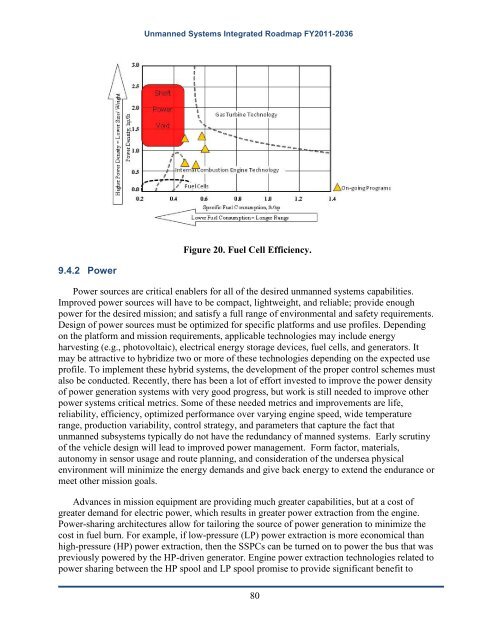Unmanned Systems Integrated Roadmap FY2011-2036 - Defense ...
Unmanned Systems Integrated Roadmap FY2011-2036 - Defense ...
Unmanned Systems Integrated Roadmap FY2011-2036 - Defense ...
Create successful ePaper yourself
Turn your PDF publications into a flip-book with our unique Google optimized e-Paper software.
9.4.2 Power<br />
<strong>Unmanned</strong> <strong>Systems</strong> <strong>Integrated</strong> <strong>Roadmap</strong> <strong>FY2011</strong>-<strong>2036</strong><br />
Figure 20. Fuel Cell Efficiency.<br />
Power sources are critical enablers for all of the desired unmanned systems capabilities.<br />
Improved power sources will have to be compact, lightweight, and reliable; provide enough<br />
power for the desired mission; and satisfy a full range of environmental and safety requirements.<br />
Design of power sources must be optimized for specific platforms and use profiles. Depending<br />
on the platform and mission requirements, applicable technologies may include energy<br />
harvesting (e.g., photovoltaic), electrical energy storage devices, fuel cells, and generators. It<br />
may be attractive to hybridize two or more of these technologies depending on the expected use<br />
profile. To implement these hybrid systems, the development of the proper control schemes must<br />
also be conducted. Recently, there has been a lot of effort invested to improve the power density<br />
of power generation systems with very good progress, but work is still needed to improve other<br />
power systems critical metrics. Some of these needed metrics and improvements are life,<br />
reliability, efficiency, optimized performance over varying engine speed, wide temperature<br />
range, production variability, control strategy, and parameters that capture the fact that<br />
unmanned subsystems typically do not have the redundancy of manned systems. Early scrutiny<br />
of the vehicle design will lead to improved power management. Form factor, materials,<br />
autonomy in sensor usage and route planning, and consideration of the undersea physical<br />
environment will minimize the energy demands and give back energy to extend the endurance or<br />
meet other mission goals.<br />
Advances in mission equipment are providing much greater capabilities, but at a cost of<br />
greater demand for electric power, which results in greater power extraction from the engine.<br />
Power-sharing architectures allow for tailoring the source of power generation to minimize the<br />
cost in fuel burn. For example, if low-pressure (LP) power extraction is more economical than<br />
high-pressure (HP) power extraction, then the SSPCs can be turned on to power the bus that was<br />
previously powered by the HP-driven generator. Engine power extraction technologies related to<br />
power sharing between the HP spool and LP spool promise to provide significant benefit to<br />
80

















